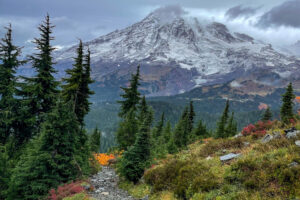You may have heard that a place is a UNESCO World Heritage Site. But what does that even mean?
In short, it means that the place is really special and worthy of designation as such.
But there’s far more to it than that. Let’s chat about it shall we?

What is a UNESCO World Heritage site?
I’ll start with a little history…
Back in 1972, the United Nations Educational, Scientific and Cultural Organization (UNESCO) adopted an international treaty called the World Heritage Convention.
This was an effort to encourage the nations of the world to come together to identify (and commit to protect) their most precious sites of natural and cultural importance. Then, from this treaty, the World Heritage List was formed.

Sites are put on the World Heritage list because something about them is valuable to the people of the world – as in all of humanity.
Whoa. That’s deep.
World Heritage sites belong to all the peoples of the world, irrespective of the territory on which they are located. – UNESCO

A World Heritage Listing isn’t only a prestigious honor, it’s a joint commitment. By being on the List, the home nation is making a commitment to preserve the site. But beyond that, should the site’s value to the world be threatened (like by war, lack of maintenance funds, or a natural disaster) – the other countries that signed the treaty are required to assist in the protection of the site.
Therefore, with so much commitment involved, you can bet your ass that places aren’t just added to this list all willy nilly-like.
There’s a whole process for being rewarded with such an honor. Let’s break it down…
What are the selection criteria?
Sites are nominated to the UNSECO World Heritage List because they “are of outstanding universal value” and meet at least one of 10 selection criteria- 6 of which are cultural, 4 are natural.
I won’t bore you with ALL of the nitty gritty details. You can read up on all of the criteria in depth on UNSECO’s site here. Instead, I’ll give you some examples:

Hallstatt, Austria for example, in on the World Heritage List for meeting two different cultural criteria. It is obviously an important place since “humankind has inhabited the valleys between huge mountains for over three millennia” mostly because they were mining for salt. A TON can be learned about the history of salt mining from Hallstatt, since they’ve been doing it here since the Bronze Age.

On the other hand, the Great Smoky Mountain National Park in the USA is on the list because it meets all four of the natural criteria. It is described as being “of exceptional natural beauty with undisturbed, virgin forest including the largest block of virgin red spruce remaining on earth.”

The Tower of London is on the list for other reasons. The infamous White Tower has been “the setting for some of the most momentous events in European and British History.” But it also meets to criteria for being an “outstanding example of a type of building” as an “example par excellence of the royal Norman castle from the late 11th century.”
Who decides what makes the World Heritage List?
So…who exactly who is in charge of deciding if a site is worthy of the list? There’s a whole bunch of people involved. Let’s break it down as simply as possible.
First, we have the World Heritage Convention. This is all of the countries that have signed the treaty and have pledged to protect their natural and cultural heritage – and also help out if another World Heritage Site is in danger. How many nations in the world would commit to such a thing? Oh….a whopping 193 of them. This is a big deal!

Next, we have the States Parties, which are basically the individual countries who have signed the treaty. They take an inventory of their cultural and natural resources within their country and put them on a master list called the “Tentative List.” Then, from their Tentative List, the State Party nominates a site.
Then, three Advisory Bodies look over all of the nominations. These Advisory Bodies basically provide expert evaluations on the nominated sites. Those are:
- International Council on Monuments and Sites (ICOMOS)
- International Union for Conservation of Nature (IUCN)
- International Centre for the Study of the Preservation and Restoration of Cultural Property (ICCROM)

The last step, is for the World Heritage Committee to meet and make decisions. Once a year, a group of 21 representatives from the State Parties (elected by the General Assembly) get together, go over the nominations and decide who makes the cut and ends up on the World Heritage List.
So, why should you care?
First let’s just acknowledge, a whole lotta international cooperation went into this whole damn thing.
As a planet we got together and agreed on something! And that something is that we should preserve places of cultural and natural importance for “the common inheritance of all mankind.” Isn’t that freaking wonderful??

In my book, that fact alone makes these sites even more special. Because the people of the world got together and agreed that they are special.
Even more impressive is that in 1994 the World Heritage Committee recognized that certain types of sites and regions of the world seemed to be over-represented on the World Heritage List (like historic and Christianity based sites in Europe) and launched an initiative to add more underrepresented site types and improve diversity in global coverage. What? This is great!!
Secondly, cultural and natural heritage sites are irreplaceable! These sites are “sources of life and inspiration,” and once destroyed, their portals to the past are erased with them. Protecting these sites is important business.
Lastly, history teaches us about who we are by understanding where we all came from. Studying and preserving parts of the past will educate us about our futures. And that *should* be important to everyone.
History is for human self-knowledge … the only clue to what man can do is what man has done. The value of history, then, is that it teaches us what man has done and thus what man is.”
R. G. Collingwood

Where are World Heritage Sites?
How many World Heritage Sites are there in the world? Quite a few actually. Currently there are 1092 sites on the World Heritage List in 162 countries. So basically, they are all over the world – as they should be, right? Chances are there is a World Heritage Site near you.
>>>Check out a map World Heritage Sites here on UNESCO’s Site.

Even better, order yourself a paper copy of the World Heritage Map here:
>>> Order the World Heritage Map – UNESCO World Heritage Centre
I’ve been to 20 World Heritage Sites so far, but that’s not nearly enough. There’s so many left on my list to see!
So join me in supporting World Heritage by getting’ out there and checkin’ them off YOUR list. Let’s celebrate humanity!
Want to do more? DONATE to the World Heritage Fund and get a map for free!

Check out some of my past blog posts to UNESCO World Heritage Sites here:
- 3 Nights in Italy’s Cinque Terre
- Getcho self outside! A weekend trip to the Smokys
- Do THIS in Hallstatt, Austria – You won’t regret it





